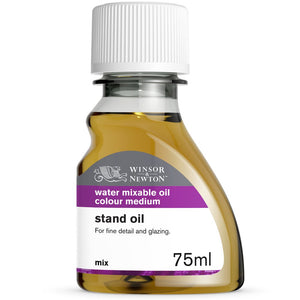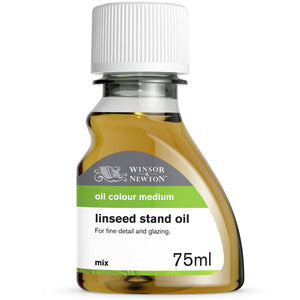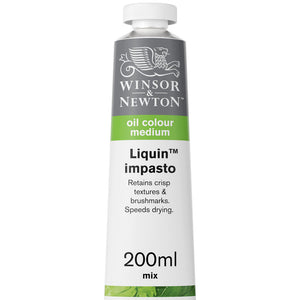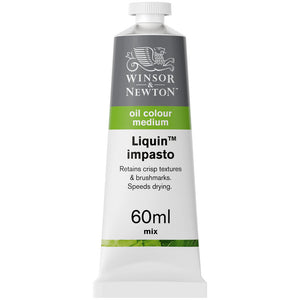
When you’re using oil paint, a composition is usually built up using different layers of colour. For example, if you’re painting a portrait, you may start with an area of background colour. On top of this you may sketch out the proportions of the portrait with another colour, and on top of that you may add further colours for the detail. The way each of these layers of colour interacts with each other is important and will affect how your finished work looks.
If you want to make the most of your painting, there are three tried and tested rules that will serve you well:
1. Fat over lean
First up is what’s known as ‘fat over lean’. This is a technique that helps protect your painting from cracking over time. This rule is better understood if considered as ‘flexible over less flexible’. Each new layer of paint should contain slightly more medium than the one underneath, this making each layer more flexible and reduces the risk of the paint underneath cracking.
There are a couple of ways to fatten your paint:
-
Using traditional oils: You can mix increasing amounts of oil into your paint layer by layer. A reliable method is to pre-mix three jars with different ratios of Stand Oil and Sansodor — for example:
- 1 part Stand Oil to 3 parts Sansodor
- 1 part Stand Oil to 2 parts Sansodor
- 1:1 ratio of Stand Oil and Sansodor
These mixtures can be kept in tightly capped jars in your studio, labelled with the ratio inside, to use as you need them. Stand Oil is the oil of choice as it is non-yellowing, but be sure not to use it in your first layer. Alternatively, you can add Stand Oil to the paint on your palette in an increasing ratio as your layers increase.
- Using Liquin: For those who prefer an easier and modern alternative, Liquin Original is a convenient and popular choice. While Liquin doesn’t technically ‘fatten’ paint like oil does, its alkyd resin content supports adhesion between layers, helping to achieve a similar result. Simply increase the Liquin content in each new layer. There’s no need to use additional oil if you’re using Liquin, making it a simpler workaround.
Whichever method you choose, the key is to ensure that each new layer is more flexible — and fully dry — before applying the next. The drying time will increase every time you create a new later.
Watch our masterclass on fat over lean below.
2. Thick over thin
Next comes ‘thick over thin’. When building up your painting, always apply thicker layers on top of thinner ones. This is because thinner layers dry faster. If you put a thin layer on top of a thick one that is still drying, the top layer may crack as the bottom one continues to cure and shift.
This rule is especially important if you enjoy using an impasto technique, as seen in many Impressionist works. Thick, bold brushstrokes need to be applied last, over well-dried thinner layers.
3. Slow-drying over fast-drying
The final rule is ‘slow-drying over fast-drying’. When building up colour, always apply slower-drying paint over layers that dry more quickly. If the slower-drying layer is underneath, it may still be drying as you add new paint, potentially causing the upper layer to shift and crack.
To avoid this, use fast-drying colours for your underpainting, saving the slower-drying pigments for final layers and details. Planning your palette with drying times in mind is essential for keeping your painting stable and crack-free.
Final tip: No matter which mediums or techniques you use, always make sure your layers are dry before adding more. These three golden rules — fat over lean, thick over thin, and slow-drying over fast-drying — work together to help you create vibrant, long-lasting oil paintings.








![W&N BLACK FINELINER LS 0.1 [CAP ON]](http://uk.winsornewton.com/cdn/shop/files/64128.jpg?crop=center&v=1736866967&width=20)
![W&N COTMAN WATERCOLOUR 8HP FLORAL POCKET SET [FRONT]](http://uk.winsornewton.com/cdn/shop/files/97499.jpg?crop=center&v=1738930795&width=20)
![WN COTMAN FLORAL POCKET SET 9PC 884955081129 [DHI]](http://uk.winsornewton.com/cdn/shop/files/136686.jpg?crop=center&v=1738930795&width=20)

![WN PROMARKER COOL GREY 3 [COMPOSITE] 884955041406](http://uk.winsornewton.com/cdn/shop/files/77586.jpg?crop=center&v=1741263144&width=20)
![W&N SERIES 7 KOLINSKY SABLE BRUSH ROUND [SHORT HANDLE]](http://uk.winsornewton.com/cdn/shop/files/11424.jpg?crop=center&v=1740568148&width=20)

![W&N GALERIA ACRYLIC TUBE 60ML TITAN WHITE 08 [COMPOSITE] 094376914061](http://uk.winsornewton.com/cdn/shop/files/9396.jpg?crop=center&v=1714072593&width=20)
![W&N GALERIA [SWATCH] TITANIUM WHITE](http://uk.winsornewton.com/cdn/shop/files/3097.jpg?crop=center&v=1714072593&width=20)
![W&N GALERIA CARDBOARD SET 10X12ML 884955097809 [OPEN]](http://uk.winsornewton.com/cdn/shop/files/138856.jpg?crop=center&v=1725031476&width=20)
![W&N GALERIA CARDBOARD SET 10X12ML [B014096] 884955097809 [FOP]](http://uk.winsornewton.com/cdn/shop/files/138855.jpg?crop=center&v=1725031475&width=20)